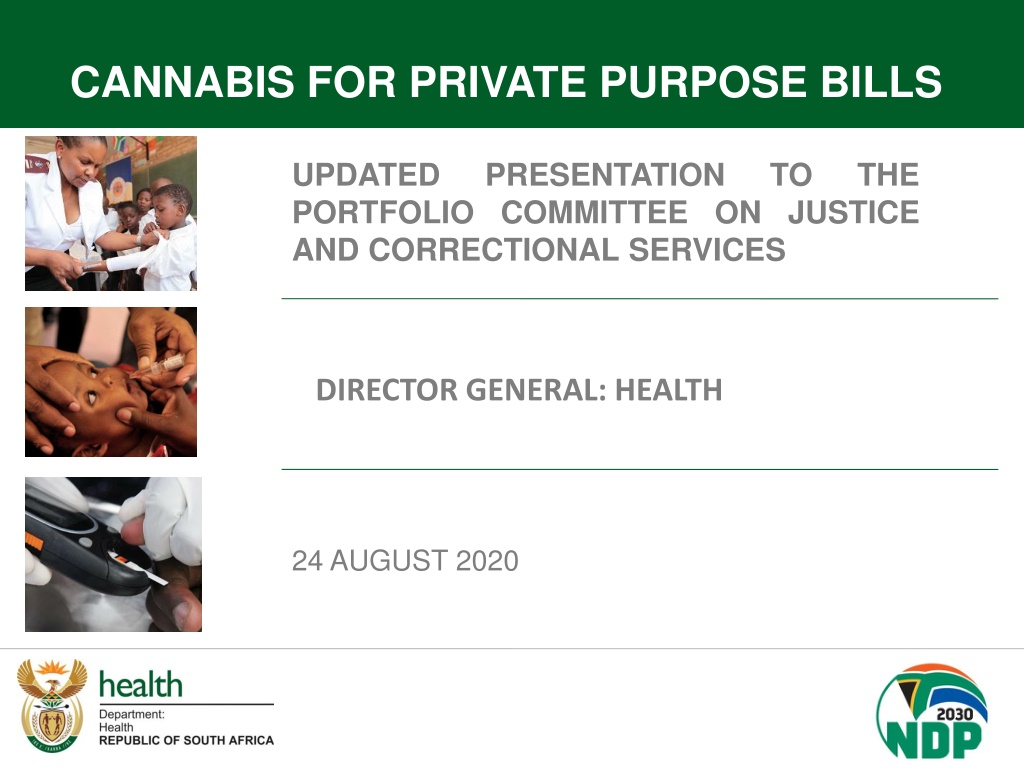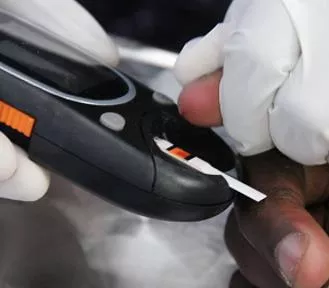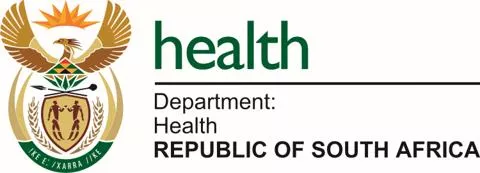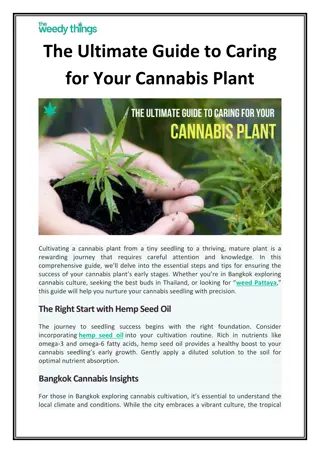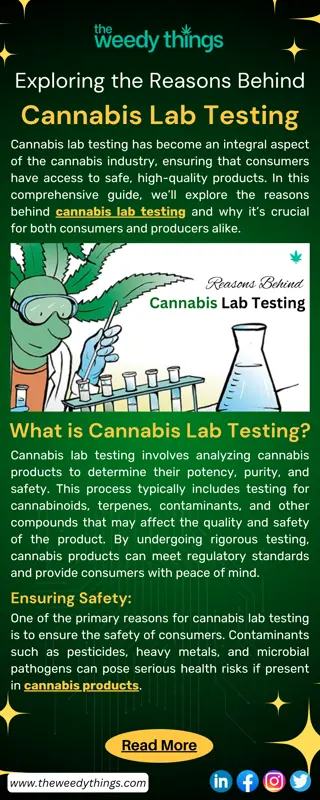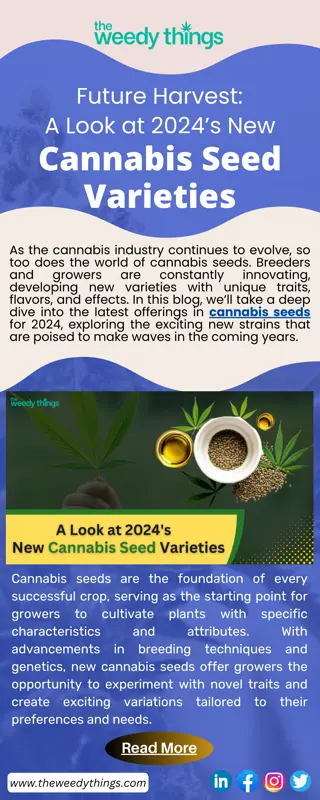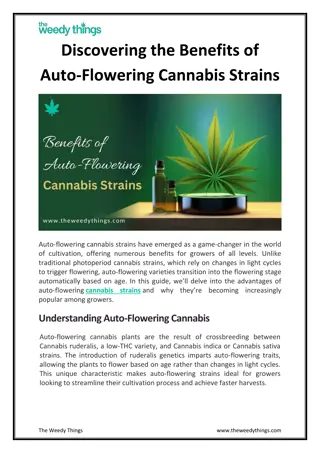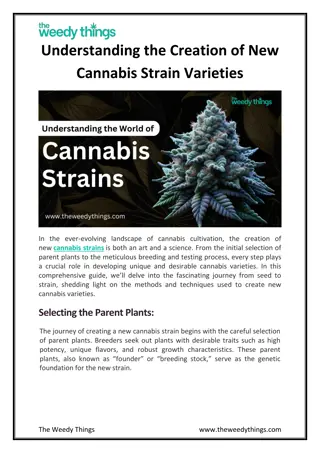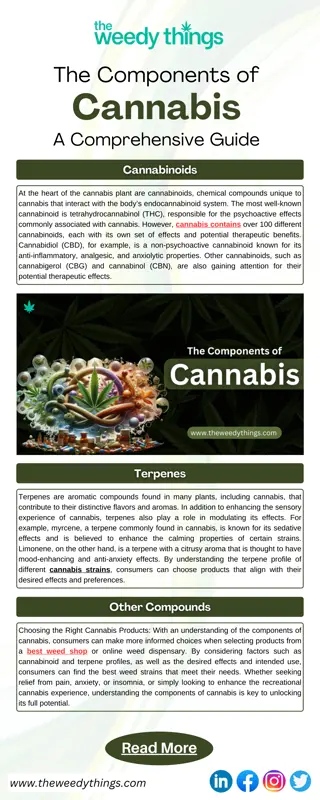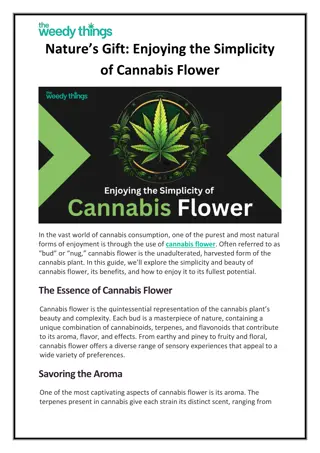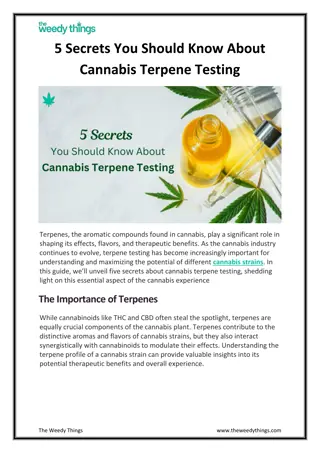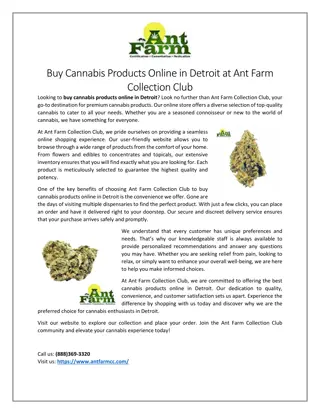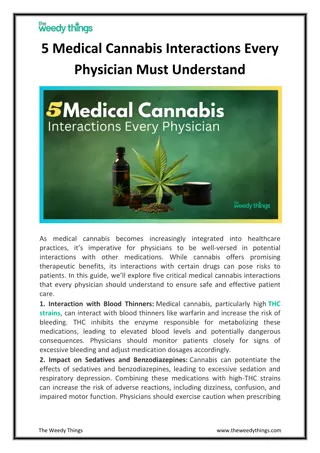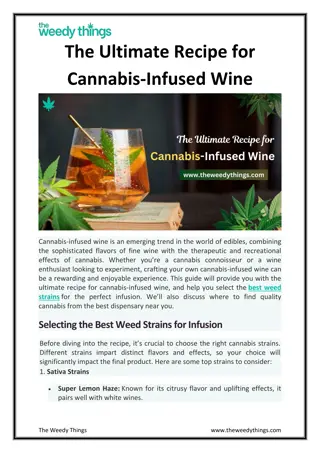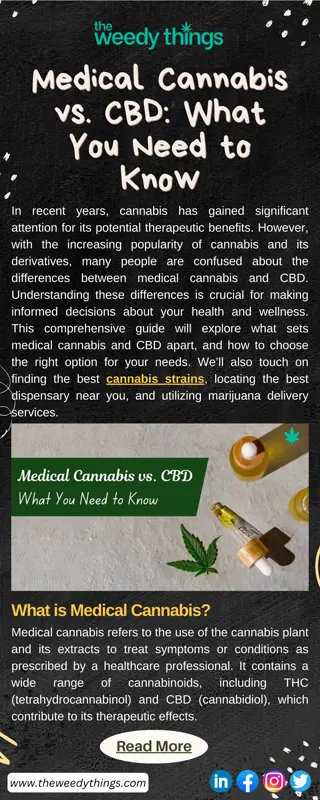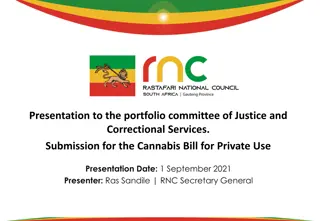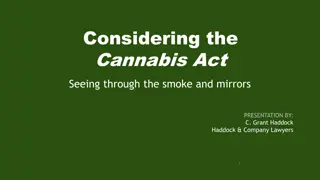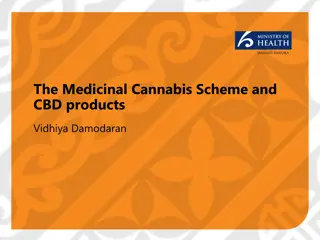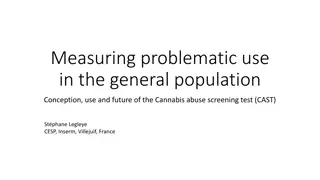Review and Amendments for Cannabis Bill Presentation
The presentation discusses the Cannabis for Private Purpose Bills, emphasizing the need for amendments to safeguard against potential risks. It covers the introduction of the bill, preamble, and definitions related to cannabis, highlighting concerns such as broadening the definition of cannabis and unintended consequences linked to THC-containing substances. Suggestions for refining the bill to ensure better protection for both adults and children are proposed.
Download Presentation

Please find below an Image/Link to download the presentation.
The content on the website is provided AS IS for your information and personal use only. It may not be sold, licensed, or shared on other websites without obtaining consent from the author. Download presentation by click this link. If you encounter any issues during the download, it is possible that the publisher has removed the file from their server.
E N D
Presentation Transcript
CANNABIS FOR PRIVATE PURPOSE BILLS UPDATED PORTFOLIO COMMITTEE ON JUSTICE AND CORRECTIONAL SERVICES PRESENTATION TO THE DIRECTOR GENERAL: HEALTH 24 AUGUST 2020
CANNABIS Bill: INTRODUCTION The legal decision to decriminalise cannabis for private use is the correct one; it is not appropriate from a human rights perspective to lock up people who use cannabis, give them a criminal record and waste state resources. While the Bill does acknowledge the need to protect children, others in the vicinity of cannabis smokers and other road users, we believe that the Bill needs amendments to mitigate risks. This may also require changes /emphases in legislation and the regulations and policies of other government departments, beyond Justice.
Preamble Preamble to Bill Protect adults and children against the harms of cannabis; The Bill, rather than protecting anyone against harms, will rather regulate access to cannabis for adults for personal use and prevent access or exposure to children. Suggested new wording: Provide access to cannabis for personal use to adults and prevent access or exposure of cannabis to children;
Clause 1: Definitions 1. cannabis means (a) the flowering or fruiting tops and the leaves of a cannabis plant that have been separated from the plant, but excludes any seed, seedling, the stalk and branches without any leaf, fruit or flower, and the roots of a cannabis plant; and (b) any substance which contains THC, Paragraph (b) broadens the definition of cannabis too wide to include food as a substance. We have proliferation of substances containing THC in the form of food and sweets available in the streets. Children will consume these THC containing food and the consequences may not be child friendly. Cannabis may not be listed as food as it does not have any nutritional value.
Clause 1: Definitions Cannabis Paragraph (b) further creates an unintended, unreasonable inclusion of the smallest amount of either a naturally occurring or synthetic form of THC as cannabis. THC is already regulated under the Medicines Act as a Schedule 6 substance. The manner in which the word cannabis is then used in the proposed legislation, may create the ability to circumvent the provisions of the Medicines Act Suggested definition of Cannabis and deletion of par(b) cannabis means the flowering or fruiting tops and the leaves of a cannabis plant that have been separated from the plant, but excludes any seed, seedling, the stalk and branches without any leaf, fruit or flower, and the roots of a cannabis plant and fresh cannabis, dried cannabis and cannabis concentrate, are classes of cannabis;
Clause 1: Definitions Cannabis Concentrate cannabisconcentrate means cannabis that has undergone a process to concentrate the THC content, and cannabis solid concentrates and cannabis liquid concentrates are classes of cannabis concentrate; Cannabis may also be concentrated for the intended purposes of obtaining high concentrated forms of other cannabinoids, not just THC. The definition should instead focus on the resultant product of the concentration process and not the intention of the concentration process. Suggested defition: "cannabis concentrate" means a concentrated cannabis substance containing THC obtained by the processing of cannabis or any cannabis derivative, and cannabis solid concentrates and cannabis liquid concentrates are classes of cannabis concentrate;
Definitions Cannabis Product cannabis product means anything that is intended for human or animal consumption which contains phytocannabinoid found in a cannabis plant; THC or any other This definition juxtaposed with the definition of consumption seems to suggest the inclusion of cannabis as food, thus the THC containing product may have adverse effect on food. The public may think that Cannabisproduct is food and may be consumed as such. The Bill on Commercialisation and Use of Cannabis Products will deal with consumption or use of Cannabis Products. Recommendation: Deletion of CannabisProduct as its use may confuse the public to think that it can be eaten or consumed as food.
Definitions Consumption consumption means to eat, drink or otherwise self-administer cannabis and consume has a corresponding meaning; Consumption seems to suggest that Cannabis has nutritional value and may be regarded as food, or it may be added to food for consumption. Recommendation: Deletion of consumption and not be used in this Bill for private use. The Bill is for private use not private consumption in the context of food
Definition Harvest "harvest" means to obtain and process cannabis from a cannabis plant; Remove processing from the definition as processing does not fall under harvesting. Harvesting should be considered separate from any post- harvest processing . Refer: Good Agricultural and Collection Practices (WHO)
Definition Hemp hemp means a plant of the genus Cannabis which (a) has a concentration of THC in the leaves and flowering heads that does not exceed the percentage as may be prescribed in terms of; and (b) is cultivated under authority of, a law that regulates its cultivation; Hemp (low THC cannabis) is a cultivar / variety of cannabis. See also General Comments on the creation of the term hemp which is for expediency of legislative drafting but may create confusion. hemp means a [plant] variety of the genus Cannabis which (a) has a concentration of THC in the leaves and flowering heads that does not exceed the percentage as may be prescribed in terms of; and (b) is cultivated under authority of, a law that regulates its cultivation;
Definition Possess in private possess in private , for purposes of section 2(1)(c) and (e), means to keep, store, transport or be in control of cannabis or a cannabis plant, respectively, in a manner that conceals it from public view; Refer to comment on the definition of cannabis and the implications for cannabis-related medicines and the possession thereof. The absence of the specific exclusion for all activities authorised in terms of the Medicines Act and the definition of cannabis result in this legislation creating an offence for the possession of cannabis-related medicines or medical devices authorised for such in terms of the Medicines Act when not concealed from public view.
Definition Smoke smoke means to inhale or exhale the smoke produced by ignited cannabis or holding or otherwise having control of ignited cannabis or any device or object that contains ignited cannabis; Definition ignores the growing heat-not-burn market, such as vapes or other Electronic Nicotine Delivery Systems which can also deliver THC. Clarity is required between the definition of smoke and consumption in order that the clarity of the consumption or smoking of cannabis in public places is unambiguous with respect to these means of administration.
Creation of new clause, clause 2 Clause 1(2) provides that The provisions of this Act do not apply to any person who is permitted or authorised in terms of any other Act of Parliament to (a) deal in cannabis plant cultivation material, cannabis plants, cannabis or a cannabis product; or (b) cultivate cannabis plants. Clause 1(2) should be a clause on its own titled Application . It seems to be misplaced under Definitions and interpretation clause. Recommendation: Create clause 2 titled Application just after clause 1.
Further inputs on new clause, clause 2 Clause 1(2) provides that the provisions of this Act do not apply to any person who is permitted or authorised in terms of any other Act of Parliament to (a) deal in cannabis plant cultivation material, cannabis plants, cannabis or a cannabis product; or (b) cultivate cannabis plants. This current exclusion does not contemplate the possession of cannabis plant cultivation material, cannabis plants, cannabis or a cannabis product, which in the case of the Medicines Act may have been arrived at by way of, but not limited to, prescription, authorisation, licensing or sale.
Further inputs on new clause, clause 2 Cont.. The sub-section should, in order to avoid any unintended consequence as already stated above, specifically exclude any person and any activity permitted or authorised in terms of the Medicines Act related to cannabis-related products. Proposed Clause: (a) in terms of the Medicines and Related Substances Act, 1965 (Act 101 of 1965), to perform any activity associated with cannabis plant cultivation material, cannabis plants, cannabis or a cannabis product; or (b) in terms of any other Act of Parliament to (i) deal in cannabis plant cultivation material, cannabis plants, cannabis or a cannabis product; or (ii) cultivate cannabis plants.
Unintended consequences of cannabis use: Adolescent Allowing cannabis for private use is likely to lead to increased use of cannabis by adolescents due to more open use and therefore greater exposure. Adolescents who are regular smokers of cannabis are at risk of having arrested psychosocial development. There is also a growing concern regarding the long-term effects of regular cannabis use on adolescent brain development. Brain development continues until the age of 25, so this is also a concern for young people in emerging adulthood. We also know there are some short-term effects in terms of cognitive functioning and memory based on research conducted in Cape Town.
Unintended consequences Adolescent Cont The Bill does address the need to protect children (defined as persons under the age of 18) but does not refer specifically to adolescents and does not go far enough in protecting adolescents from access and exposure to cannabis. Among other things, it needs to specify that anyone giving or selling cannabis to a person under 18 or failing to protect a child or adolescent from accessing cannabis should be charged with having committed a Class A offence. This should be viewed as a minor offense/infringement.
Risk of harm to others There is also the very real risk of substantial exposure of people who do not use cannabis to second-hand cannabis smoke. It is unlikely that the provisions of the Bill are sufficient to prevent this risk from occurring. The Bill does take this into account to some extent by making it a Class D offence to smoke cannabis in the immediate presence of a non-consenting adult and to make it a Class C offence to smoke cannabis in the immediate presence of a child.
Risk of harm to others, Cont It might be helpful to specify a distance, whether inside or outside. These offenses should be increased to Class C and B offenses respectively. The purpose of the Bill is private use, and smoking in the presence of children and adolescents or non-consenting adults cannot be deemed private.
Risk of motor vehicle crashes Cannabis use affects perceptual motor functioning and thus it increases the risk of motor vehicle crashes. The Bill does take this into account to some extent by amending the National Road Traffic Act No. 93 of 1996, but sufficient attention and resources need to be given to training and equipping police to detect cannabis-impaired driving and prosecuting impaired drivers. It is not clear to what extent financial and other resources be made available to support this training and equipment.
Likely increase in demand for mental health and substance abuse treatment While there is only a small risk of cannabis triggering latent mental health problems among people with underlying risks for these conditions, it is not negligible. Local research has highlighted the burden of cannabis- induced psychoses on under-resourced psychiatric services in KZN, the Eastern Cape and the Western Cape. It has also highlighted the role that it plays in inducing first- episode psychoses. Any increased use of cannabis (which is likely at a population level when cannabis is decriminalized) is likely to increase the need for psychiatric services. These services are already chronically under-resourced and are unlikely to cope with an increased demand.
Likely increase in demand for mental health and substance abuse treatment Cont.. In addition, currently cannabis comprises between 22% (Eastern Cape) and 40% (Limpopo and Mpumalanga) of drug treatment demand in South Africa, and between 24% (Eastern Cape) and 77% (Free State, North West, Northern Cape) of drug treatment demand among persons 19 years and younger. This has increased over the past decade, except in Limpopo and Mpumalanga. Funds need to be provided to address increasing demand for mental health and drug treatment services for persons who will inevitably experience problems with the private use of cannabis, including some chronic users becoming dependent on cannabis (dependence syndrome).
Need for monitoring of use and harms We also have concerns that the Bill will cause a slippery slope (de factor legalisation) and that we will not have the means or will to go after widespread (illegal) cannabis growing, trading, use in the streets, etc. The public should at least be aware of the harms associated with cannabis use and presenting further public health information on this in an accessible format is essential.
Need for monitoring of use and harms, Cont Improved population level monitoring of use and associated harms and the reporting of these harms could increase public awareness of the potential risks associated with using cannabis. Improved monitoring will pinpoint where action is needed to address harms.
Collection of indicators Indicators are needed in the following areas and they need to Indicators are needed in the following areas and they need to be collected and collated on a periodic basis be collected and collated on a periodic basis: Extent and patterns of cannabis use among adults and adolescents (not just prevalence of use, but also frequency of use, quantity of use, potency of cannabis, and mode of use (especially edibles)). Cannabis-related road traffic offenses. Cannabis-related trauma presentations. Cannabis-related demand for psychiatric/mental health and substance abuse treatment. Cannabis induced psychosis.
THE END THANK YOU
